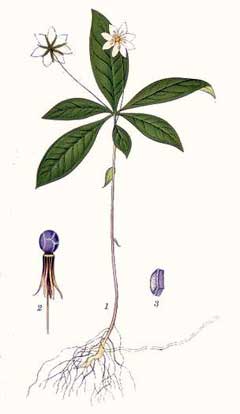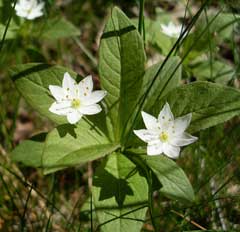 |
|
commons.wikimedia.org/wiki/File:134_Trientalis_europaea.jpg |
 |
|
Translate this page:
Summary
Physical Characteristics

 Trientalis europaea is a PERENNIAL growing to 0.3 m (1ft). It is in flower from June to July. The species is hermaphrodite (has both male and female organs) and is pollinated by Insects.
Trientalis europaea is a PERENNIAL growing to 0.3 m (1ft). It is in flower from June to July. The species is hermaphrodite (has both male and female organs) and is pollinated by Insects.
Suitable for: light (sandy), medium (loamy) and heavy (clay) soils. Suitable pH: mildly acid and neutral soils and can grow in very acid soils.
It can grow in semi-shade (light woodland) or no shade. It prefers moist soil.
UK Hardiness Map
US Hardiness Map
Synonyms
Plant Habitats
Woodland Garden Dappled Shade; Shady Edge;
Edible Uses
References More on Edible Uses
Medicinal Uses
Plants For A Future can not take any responsibility for any adverse effects from the use of plants. Always seek advice from a professional before using a plant medicinally.
Emetic Vulnerary
The root is emetic[4]. The plant was formerly esteemed as an ingredient in an ointment for treating wounds[4].
References More on Medicinal Uses
The Bookshop: Edible Plant Books
Our Latest books on Perennial Plants For Food Forests and Permaculture Gardens in paperback or digital formats.

Edible Tropical Plants
Food Forest Plants for Hotter Conditions: 250+ Plants For Tropical Food Forests & Permaculture Gardens.
More

Edible Temperate Plants
Plants for Your Food Forest: 500 Plants for Temperate Food Forests & Permaculture Gardens.
More

More Books
PFAF have eight books available in paperback and digital formats. Browse the shop for more information.
Shop Now
Other Uses
References More on Other Uses
Cultivation details
We have very little information on this species and would suggest growing the plant in an acid soil in light shade[K]. See the plants native habitat for more ideas on its cultivation needs.
References Carbon Farming Information and Carbon Sequestration Information
Temperature Converter
Type a value in the Celsius field to convert the value to Fahrenheit:
Fahrenheit:
The PFAF Bookshop
Plants For A Future have a number of books available in paperback and digital form. Book titles include Edible Plants, Edible Perennials, Edible Trees,Edible Shrubs, Woodland Gardening, and Temperate Food Forest Plants. Our new book is Food Forest Plants For Hotter Conditions (Tropical and Sub-Tropical).
Shop Now
Plant Propagation
Seed - we have no information for this species but suggest sowing the seed in spring in a cold frame. When they are large enough to handle, prick the seedlings out into individual pots and plant them out in early summer. If you have sufficient seed it could be worthwhile trying an outdoor sowing in situ in mid spring.
Other Names
If available other names are mentioned here
Native Range
TEMPERATE ASIA: Russian Federation (Altay, Buryatia, Chita, Gorno-Altay, Irkutsk, Kemerovskaja oblast, Krasnoyarsk, Kurganskaja oblast, Novosibirsk, Omsk, Tomsk, Tyva, Respublika, Yakutia-Sakha), Russian Federation-Far East (Far East), China (Hebei Sheng, Heilongjiang Sheng, Jilin Sheng, Nei Mongol Zizhiqu), Japan (Hokkaidô, Honshu, Shikoku) NORTHERN AMERICA: Canada (Northwest Territories, Yukon, Saskatchewan, Alberta, British Columbia), United States (Alaska, Idaho, Oregon, Washington, California) EUROPE: Denmark, Finland, United Kingdom, Iceland, Norway, Sweden, Austria, Belgium, Switzerland, Czech Republic, Germany, Netherlands, Poland, Slovakia, Russian Federation (European part), Belarus, Estonia, Lithuania, Latvia, Moldova, Ukraine, Italy, Romania, Slovenia, France (incl. Corsica)
Weed Potential
Right plant wrong place. We are currently updating this section.
Please note that a plant may be invasive in one area but may not in your area so it's worth checking.
Conservation Status
IUCN Red List of Threatened Plants Status :

Growth: S = slow M = medium F = fast. Soil: L = light (sandy) M = medium H = heavy (clay). pH: A = acid N = neutral B = basic (alkaline). Shade: F = full shade S = semi-shade N = no shade. Moisture: D = dry M = Moist We = wet Wa = water.
Now available:
Food Forest Plants for Mediterranean Conditions
350+ Perennial Plants For Mediterranean and Drier Food Forests and Permaculture Gardens.
[Paperback and eBook]
This is the third in Plants For A Future's series of plant guides for food forests tailored to
specific climate zones. Following volumes on temperate and tropical ecosystems, this book focuses
on species suited to Mediterranean conditions—regions with hot, dry summers and cool, wet winters,
often facing the added challenge of climate change.
Read More
Expert comment
Author
L.
Botanical References
17
Links / References
For a list of references used on this page please go here
Readers comment